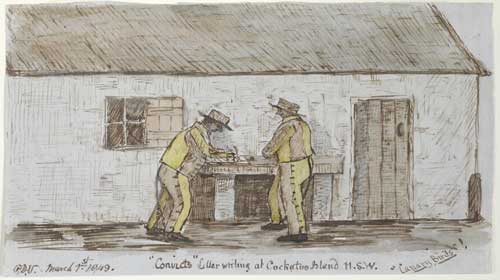The convict system
Between 1788 and 1868, 165,000 convicts were transported to Australia. Transportation in New South Wales officially ceased in 1840, although there was a short-lived revival in 1849. During that period there were gradual changes in living conditions for the convicts.
Under Governor Phillip and the early governors most convicts were employed on public works constructing roads, bridges and public buildings and cultivating government farms. Female convicts were generally employed as domestic servants to the officers. As the colony developed and free immigration increased, convicts were assigned to work for free settlers and small landholders. In addition, the growing number of freed convicts, or emancipists, were given positions of trust and grants of land. By the mid 1830s the vast majority of convicts were assigned to private employment.
"Convicts" letter writing at Cockatoo Island, NSW, "Canary Birds", 1849, by Phillipe de Vigors
Ink and watercolour. SSV/39
Until 1810 the government issued convicts ordinary civilian clothing or 'slops'. However, with the increasing number of free settlers, it became necessary to set the convicts apart. The new uniform included winter clothing which consisted of a coarse woollen jacket, a waistcoat of yellow or grey cloth, a pair of trousers, a pair of woollen stockings (long socks), a pair of shoes, two cotton or linen shirts, a neckerchief and hat.
Governor Philip founded a system of labour in which convicts were employed according to their skills. In England they may have been carpenters, cooks, servants, shepherds and farmers. Educated convicts were set to the relatively easy work of record-keeping for the convict administration. From 1810, convicts were seen as a source of labour to build and maintain the public facilities roads, bridges, courthouses and hospitals. Convicts also worked for free settlers and small land holders.
Through good behaviour convicts were often granted a ticket-of-leave or pardon before their full sentence was served.
A survey of convict records indicates that men and women were transported to New South Wales for a wide variety of offences. From the beginning the most common offence was theft which included pick-pocketing, sheep and horse stealing, highway robbery, burglary, housebreaking and receiving stolen goods. In many cases the theft was associated with violence. More unusual were the crimes of rape, manslaughter, murder, forgery and bigamy. Most of the transportees were town thieves, mainly pick-pockets and shoplifters, and among their number were many young people.
Official government records, shipping lists and court records often provide only brief details of the lives and crimes of convicts sent to Australia. Through the Library's holdings of contemporary newspaper reports, broadsides, personal diaries and letters, both the ordinary and extraordinary stories of convicts can be told.
Margaret Catchpole stole a horse and rode it to London. She was transported in 1801.
James Greenacre was convicted for murder in 1837.
> Discover other aspects of convict life in On the Run: Daring Convict Escapes - a Library exhibition







